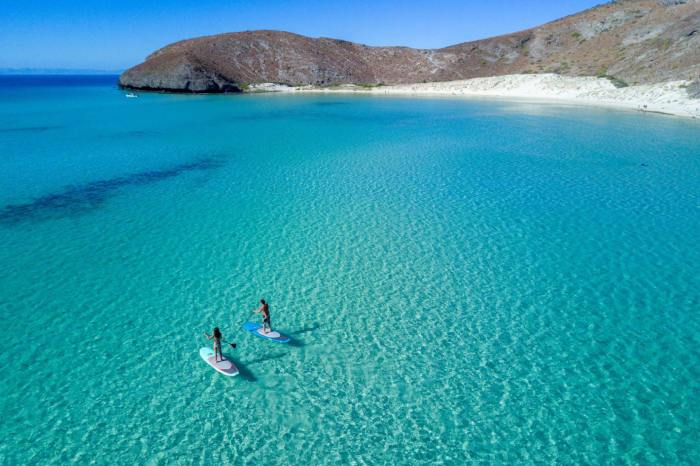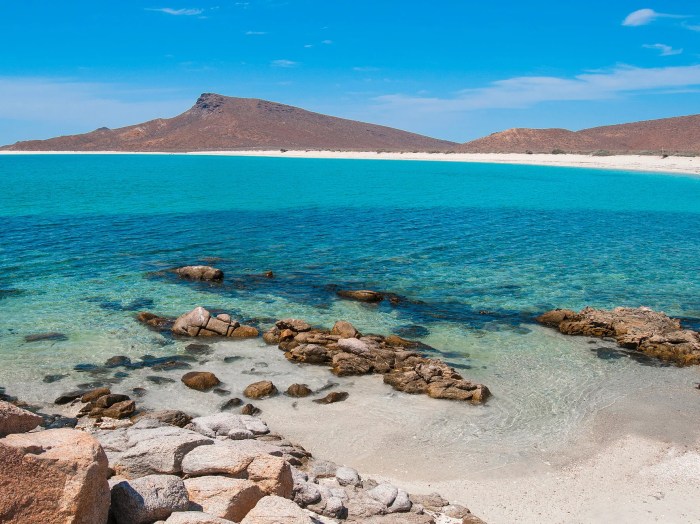Baja California Sur, a peninsula located at the southernmost tip of Mexico, is a land of captivating contrasts and breathtaking natural beauty. From its rugged coastline and towering mountain ranges to its vast deserts and diverse flora and fauna, Baja California Sur offers a unique and unforgettable travel experience.
Steeped in history and culture, Baja California Sur boasts a rich tapestry of influences, from its pre-Columbian roots to its Spanish colonial past and present-day Mexican traditions. The peninsula’s cultural heritage shines through in its vibrant music, traditional cuisine, and warm hospitality.
Baja California Sur: Geographical Overview

Baja California Sur, the southern portion of the Baja California Peninsula, is a geographically diverse state in Mexico. It is bordered by the Pacific Ocean to the west, the Gulf of California to the east, and the state of Baja California to the north. With an area of approximately 73,475 square kilometers (28,373 square miles), it is the third largest state in Mexico.
Shape and Location, Baja california sur
Baja California Sur is a long, narrow peninsula that extends approximately 1,247 kilometers (775 miles) from the southern tip of Baja California to the city of La Paz at the southern end. It is separated from mainland Mexico by the Gulf of California and from the Baja California Peninsula by the Isthmus of La Paz.
Coastline
Baja California Sur has a long and rugged coastline, with numerous bays, inlets, and islands. The western coast is characterized by high cliffs, sandy beaches, and rocky headlands. The eastern coast is more sheltered, with numerous lagoons and estuaries.
Mountain Ranges
Baja California Sur is home to several mountain ranges, including the Sierra de la Giganta, the Sierra de la Laguna, and the Sierra de San Pedro Mártir. The Sierra de la Giganta is the highest mountain range in the state, with peaks reaching over 3,000 meters (9,800 feet) above sea level.
Deserts
Baja California Sur is also home to several deserts, including the Vizcaíno Desert, the Magdalena Desert, and the San Felipe Desert. These deserts are characterized by their arid climate, sparse vegetation, and unique plant and animal life.
Baja California Sur
History of Baja California Sur
Baja California Sur’s history is a captivating blend of indigenous cultures, European exploration, and Mexican influence.
Before European arrival, the region was inhabited by various Native American tribes, including the Pericú, Guaycura, and Cochimi. These tribes lived a nomadic lifestyle, subsisting on hunting, gathering, and fishing.
In 1533, Spanish explorer Hernán Cortés arrived in Baja California Sur. The Spanish established missions and settlements along the coast, bringing with them their language, religion, and culture.
In 1821, Mexico gained independence from Spain, and Baja California Sur became a Mexican territory. However, it remained relatively isolated and undeveloped until the late 19th century.
In the early 20th century, Baja California Sur experienced a period of economic growth due to the development of the mining and tourism industries. The region became a popular destination for American tourists, who were drawn to its beautiful beaches and desert landscapes.
Culture of Baja California Sur
The culture of Baja California Sur is a unique blend of Spanish, Mexican, and Native American traditions.
The Spanish influence is evident in the region’s architecture, music, and cuisine. Many of the towns and cities in Baja California Sur have colonial-era buildings, and traditional Mexican music, such as mariachi, is popular.
The Mexican influence is also strong in Baja California Sur. The region’s cuisine is similar to that of mainland Mexico, and Spanish is the official language.
Baja California Sur is a captivating destination known for its stunning beaches and vibrant marine life. While exploring this beautiful region, consider venturing to Belmore , a charming boutique hotel nestled on the secluded coast. Belmore offers a tranquil retreat, where you can relax in luxurious accommodations, indulge in delectable cuisine, and embrace the serenity of Baja California Sur.
The Native American influence is most evident in the region’s art and crafts. Many local artisans create traditional pottery, jewelry, and textiles using techniques that have been passed down for generations.
Baja California Sur, a breathtaking Mexican peninsula, boasts stunning beaches and vibrant marine life. While exploring its natural wonders, consider a visit to Alexandra Palace , a magnificent Victorian palace in London. Its captivating history and stunning architecture offer a delightful contrast to Baja California Sur’s natural allure, creating a memorable travel experience.
Baja California Sur
Baja California Sur: Economy and Tourism
Baja California Sur’s economy is primarily driven by tourism, agriculture, and fishing. Tourism is the most important sector, contributing significantly to the state’s GDP and employment. The state’s stunning natural beauty, including its pristine beaches, deserts, and marine life, attracts millions of tourists annually. Major tourist attractions include the Cabo San Lucas Arch, the Sea of Cortez, and the Sierra de la Laguna Mountains.
Agriculture is another important economic sector in Baja California Sur. The state is known for its production of tomatoes, cucumbers, and peppers, which are exported to markets in the United States and Canada. Fishing is also a significant industry, with the state’s waters being home to a variety of fish species, including tuna, swordfish, and marlin.
However, Baja California Sur’s economy has faced challenges in recent years, including the impact of COVID-19. The pandemic has led to a sharp decline in tourism, which has had a significant impact on the state’s economy. The state is working to diversify its economy and reduce its reliance on tourism, including promoting renewable energy development and attracting new industries.
Baja California Sur
Baja California Sur: Flora and Fauna
Baja California Sur is a land of diverse flora and fauna, boasting a unique array of species that have adapted to its arid climate and desert environment. The region is home to a wide variety of plants, including cacti, succulents, and other drought-tolerant species. It also supports a diverse range of animal life, including reptiles, birds, and marine mammals.
Endemic Species
Baja California Sur is home to a number of endemic species, meaning they are found nowhere else on Earth. These include the San Pedro Mártir agave, the Cedros Island deer, and the Guadalupe fur seal. These species have evolved to survive in the harsh conditions of the desert, and they play an important role in the region’s ecosystem.
Baja California Sur is a captivating destination with stunning beaches and rich history. If you’re planning a trip, consider adjusting your watch to austin time , as it is one hour behind Pacific Time, which Baja California Sur observes. This time difference allows for more daylight hours to explore the region’s natural wonders, such as the UNESCO-listed Islas Revillagigedo Archipelago, known for its diverse marine life.
Adaptations to Arid Climate
The plants and animals of Baja California Sur have developed a number of unique adaptations to help them survive in the arid climate. Many plants have thick, waxy leaves that help to retain water. Some plants also have deep roots that can reach down to underground water sources. Animals have also adapted to the lack of water, with many species being able to survive on very little water.
Conservation Efforts
The biodiversity of Baja California Sur is under threat from a number of factors, including habitat loss, climate change, and invasive species. However, there are a number of conservation efforts underway to protect the region’s unique flora and fauna. These efforts include the creation of protected areas, the restoration of degraded habitats, and the control of invasive species.
Baja California Sur
Baja California Sur: Infrastructure and Development
Baja California Sur’s infrastructure has undergone significant development in recent years, driven by tourism and economic growth. The state has a well-developed transportation system, including a network of highways and airports. The state’s energy sector is primarily reliant on fossil fuels, but there is growing interest in renewable energy sources. Baja California Sur also has a robust communication system, with high-speed internet access available in major cities and towns.
Despite these advancements, challenges remain in Baja California Sur’s infrastructure. The state’s transportation system faces congestion and safety issues, particularly during peak tourist seasons. The energy sector needs to diversify to reduce reliance on fossil fuels and ensure energy security. Additionally, there is a need to improve communication infrastructure in rural areas to bridge the digital divide.
Opportunities for infrastructure development in Baja California Sur include investments in sustainable transportation solutions, such as public transportation and bike lanes. The state can also capitalize on its renewable energy potential to develop a cleaner and more resilient energy system. Public-private partnerships can play a vital role in financing and implementing infrastructure projects in Baja California Sur.
Baja California Sur
Environmental Issues
Baja California Sur faces several environmental challenges, including:
- Water scarcity: The region has limited freshwater resources, and the demand for water is increasing due to population growth and tourism.
- Pollution: Air and water pollution are significant problems in Baja California Sur, primarily due to industrial activities and tourism.
- Climate change: The region is vulnerable to the effects of climate change, including rising sea levels, increased temperatures, and more frequent and intense storms.
These environmental issues have significant impacts on Baja California Sur’s ecosystems, economy, and population:
- Ecosystems: Water scarcity, pollution, and climate change are damaging the region’s ecosystems, including its unique marine and desert habitats.
- Economy: The tourism industry, a major economic driver for Baja California Sur, is threatened by environmental degradation.
- Population: Water scarcity and pollution can affect human health and well-being.
To address these challenges, Baja California Sur has implemented various strategies and policies, including:
- Water conservation: The government has implemented water conservation measures, such as desalination plants and rainwater harvesting.
- Pollution control: The government has established regulations to reduce air and water pollution, and is promoting sustainable tourism practices.
- Climate change adaptation: The government is working to adapt to the effects of climate change, such as building seawalls and planting trees.
Final Thoughts

Baja California Sur is a destination that promises adventure, relaxation, and cultural immersion. Whether you seek to explore its pristine beaches, hike through its rugged mountains, or simply soak up the warm hospitality of its people, Baja California Sur has something to offer every traveler. As you venture into this extraordinary peninsula, prepare to be captivated by its natural beauty, rich history, and vibrant culture.
Essential Questionnaire
What is Baja California Sur known for?
Baja California Sur is renowned for its stunning natural beauty, including its pristine beaches, rugged mountains, and vast deserts. It is also home to a diverse array of flora and fauna, including many endemic species.
What are the major tourist attractions in Baja California Sur?
Baja California Sur offers a wide range of tourist attractions, including the Cabo San Lucas Arch, the Sea of Cortez, the Sierra de la Laguna Mountains, and the whale watching lagoons of Magdalena Bay.
What is the best time to visit Baja California Sur?
The best time to visit Baja California Sur is during the winter months (November to April) when the weather is mild and sunny. However, the peninsula can be enjoyed year-round, with each season offering its own unique experiences.